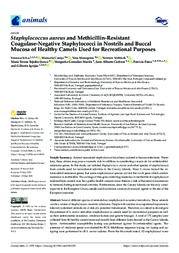Staphylococcus aureus and Methicillin-resistant coagulase-negative staphylococci in nostrils and buccal mucosa of healthy camels used for recreational purposes
Staphylococcus aureus and Methicillin-resistant coagulase-negative staphylococci in nostrils and buccal mucosa of healthy camels used for recreational purposes
Autoria: SILVA, V.; CANIÇA, M.; MANAGEIRO, v.; VERBISCK, N. V.; TEJEDOR-JUNCO, M. T.; GONZÁLEZ-MARTIN, M.; CORBERA, J. A.; POETA, P.; IGREJAS, G.
Resumo: Several different species of animals host staphylococci as normal microbiota. These animals can be a source of staphylococci zoonotic infections. People with routine or occupational exposure to infected/colonized animals are at risk of a potential transmission. Therefore, we aimed to investigate the presence of S. aureus and other staphylococci in camels used for recreational purposes as well as their antimicrobial resistance, virulence factors and genetic lineages. A total of 172 samples were collected from 86 healthy camels (nose and mouth) from different farms located in the Canary Islands, Spain. Antimicrobial susceptibility testing was performed against 14 antimicrobial agents. The presence of virulence genes was studied by PCR. Multilocus sequence typing, spa typing and agr typing were performed in all S. aureus isolates. From the 86 camels tested, 42 staphylococci were isolated, of which there were 11 S. aureus, 13 S. lentus, 12 S. sciuri, 3 S. xylosus, S. epidermidis, S. hominis and S. chromogenes. Staphylococci isolates were resistant to penicillin, ciprofloxacin, clindamycin and fusidic acid. All S. aureus isolates harbored the hla, hlb and hld virulence genes. S. aureus isolates were ascribed to three sequence types (STs) and three spa types. All S. aureus isolates belonged to agr type III. Camels from Gran Canaria used in recreational purposes have a moderate prevalence of S. aureus and other coagulase-negative staphylococci. Nevertheless, S. aureus isolates are susceptible to almost all antibiotics tested.
Ano de publicação: 2022
Tipo de publicação: Artigo de periódico
Unidade: Embrapa Gado de Corte
Palavras-chave: Contaminação Bacteriana
Observações
1 - Por padrão são exibidas publicações dos últimos 20 anos. Para encontrar publicações mais antigas, configure o filtro ano de publicação, colocando o ano a partir do qual você deseja encontrar publicações. O filtro está na coluna da esquerda na busca acima.
2 - Para ler algumas publicações da Embrapa (apenas as que estão em formato ePub), é necessário ter, no celular ou computador, um desses softwares gratuitos. Sistemas Android: Google Play Livros; IOS: iBooks; Windows e Linux: software Calibre.
Acesse outras publicações
Acesse a Base de Dados da Pesquisa Agropecuária (BDPA) para consultar o acervo completo das bibliotecas da Embrapa.

